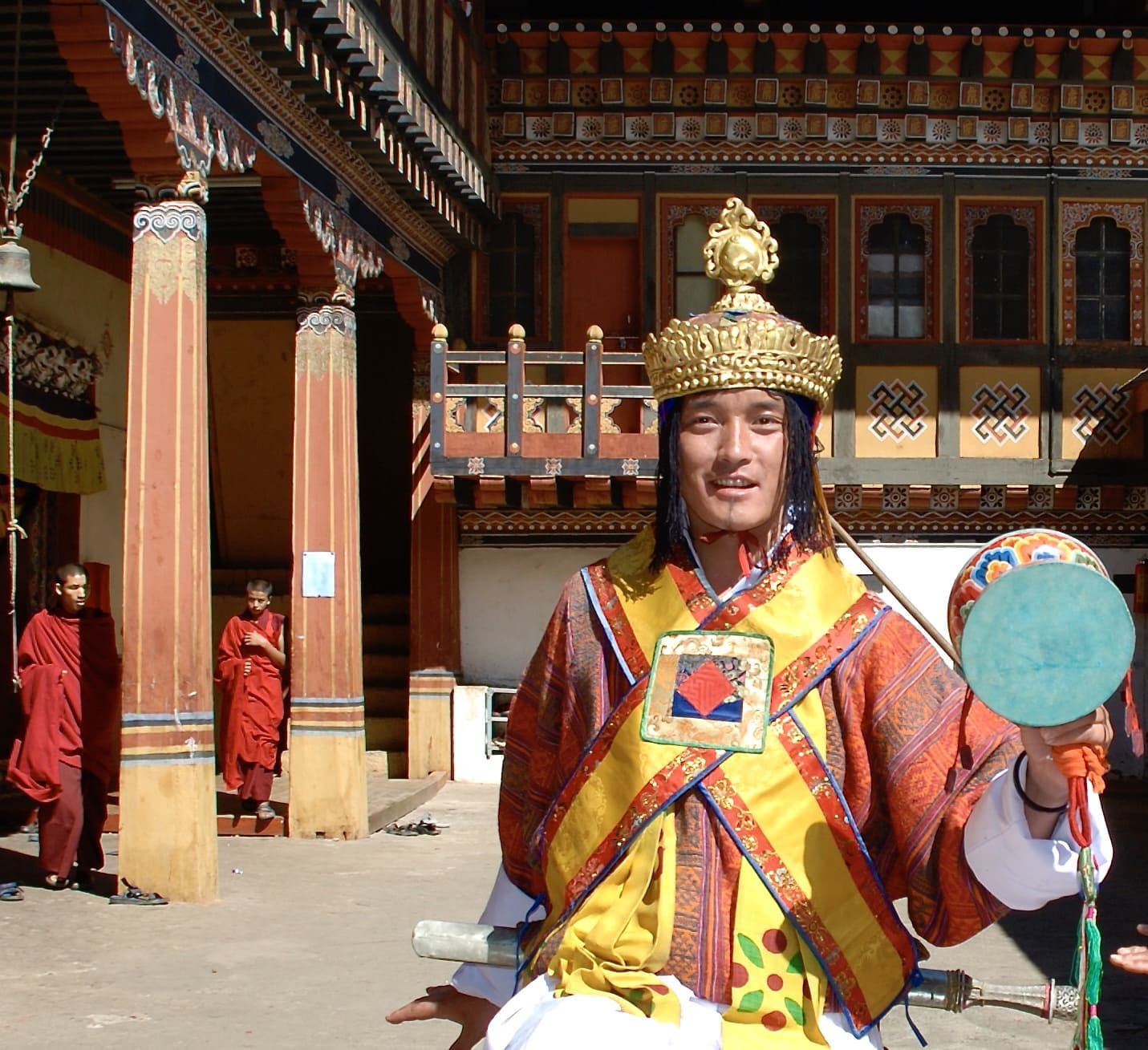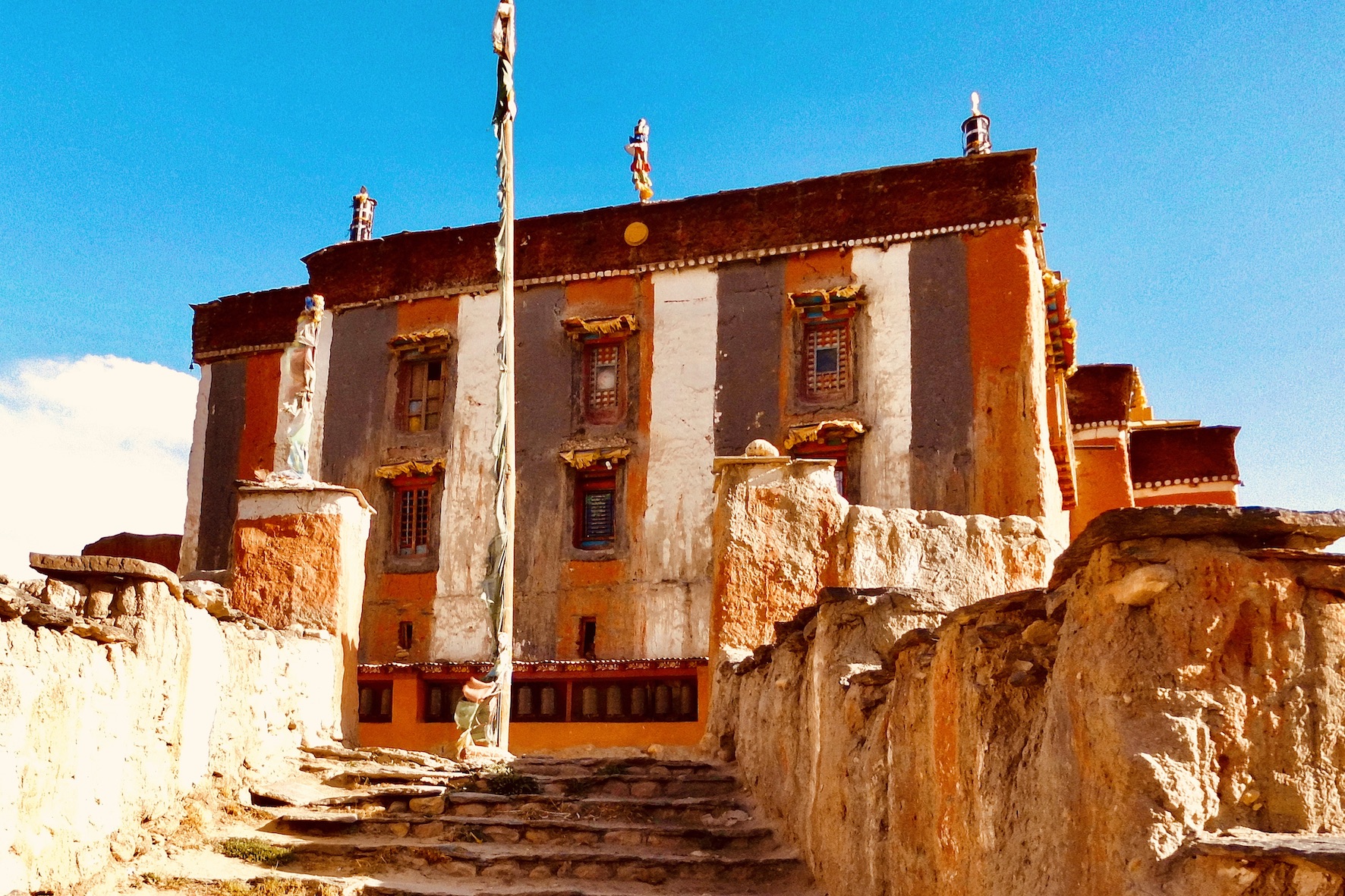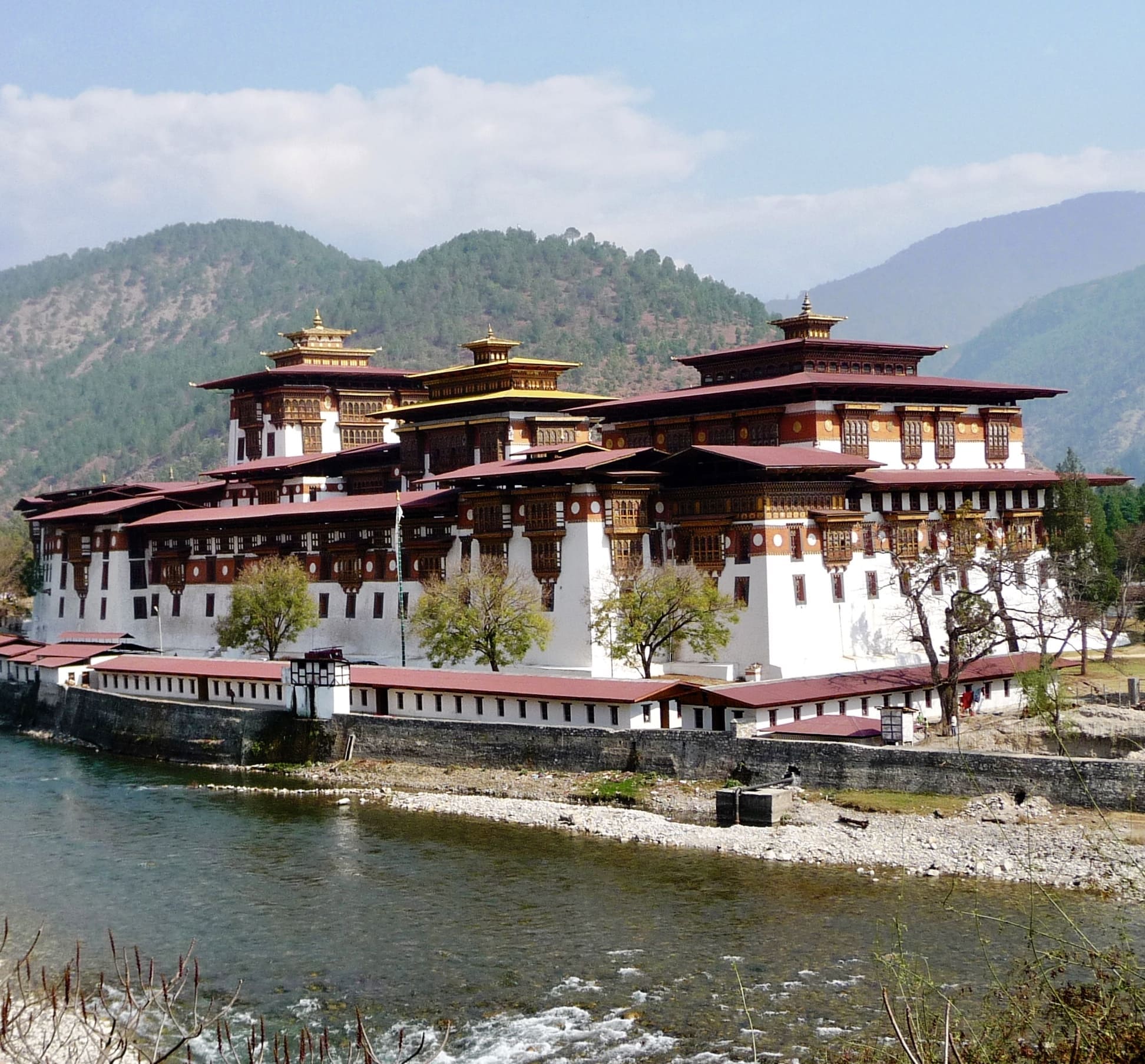You can contact us by e-mail or phone
from uk
01405 862917
outside uk
+44 1405 862917
01405 862917
+44 1405 862917
The Ultimate Bhutan Tour
All Meals Included
Duration
Accommodation
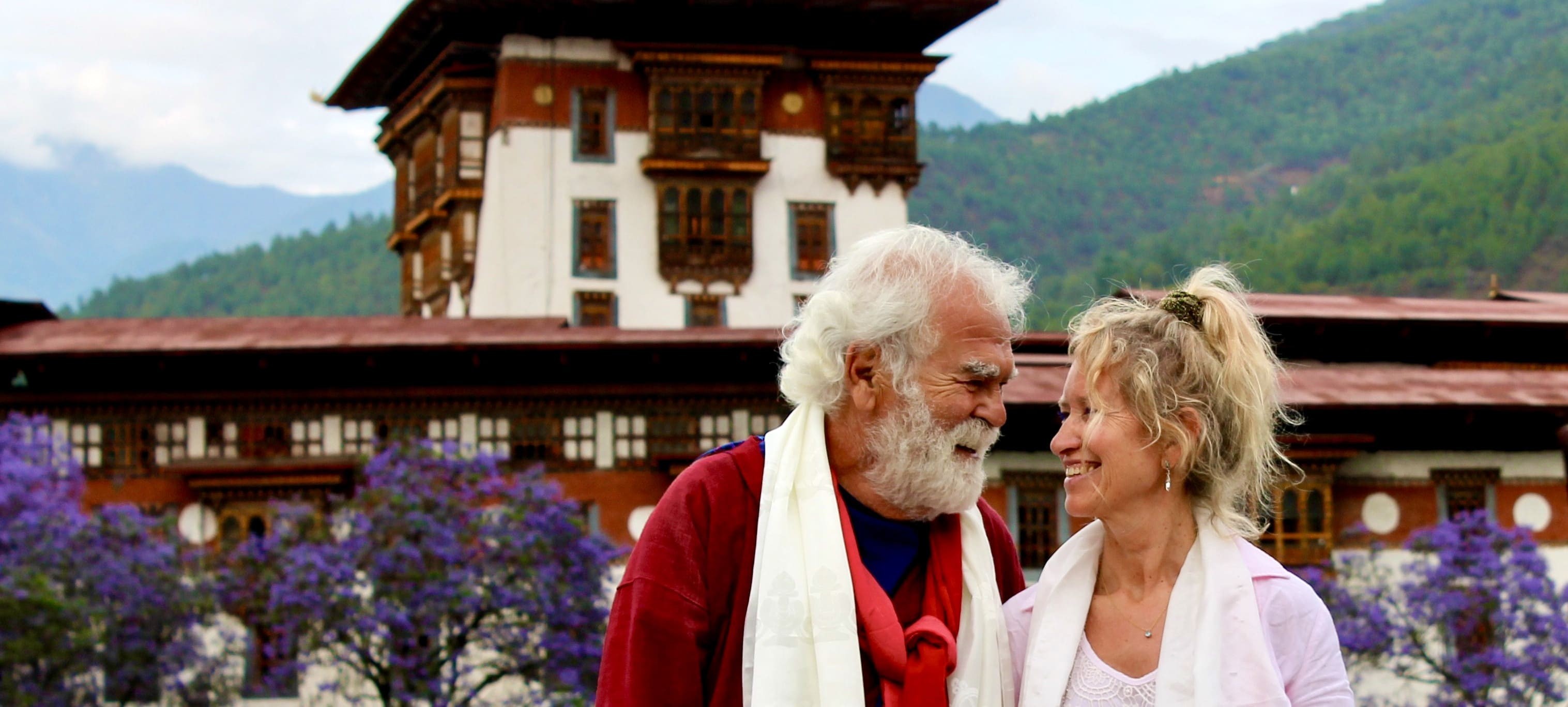
Trip Overview
This two-week Bhutan tour journeys overland from Paro as far east as the stunning Bumthang Valley.
The tour incorporates all the major Bhutan highlights along the way. With impressive Dzongs, Monasteries, palaces, and other sites of religious significance, there’s also nature and rural Bhutan to discover on this in-depth Bhutan cultural tour. Returning to Paro by way of a quick internal flight, you then head west and into the delightful and once “off limits” Haa Valley before rounding out this fascinating Bhutan adventure with a walk to the iconic Taktsang Monastery—The Tiger's Nest. As with all our custom Bhutan tours, this itinerary can be customised.
This two-week Bhutan tour journeys overland from Paro as far east as the stunning Bumthang Valley.
-
The tour incorporates all the major Bhutan highlights along the way. With impressive Dzongs, Monasteries, palaces, and other sites of religious significance, there’s also nature and rural Bhutan to discover on this in-depth Bhutan cultural tour. Returning to Paro by way of a quick internal flight, you then head west and into the delightful and once “off limits” Haa Valley before rounding out this fascinating Bhutan adventure with a walk to the iconic Taktsang Monastery—The Tiger's Nest. As with all our custom Bhutan tours, this itinerary can be customised.
Example Itinerary
-
-
Day 1Arrive Paro Transfer to Paro Hotel
-
Day 2Paro Sightseeing
-
Day 3Thimpu & Cheri Gompa
-
Day 4Over the Dochu La to Punakha
-
Day 5Punakha Valley & Punakha Dzong
-
Day 6Over the Pele La to the Gangtey Valley
-
Day 7Gangtey and to Trongsa
-
Day 8To Bumthang
-
Day 9Explore Bumthang
-
Day 10Fly/Drive to Paro
-
Day 11Across the Cheli La to Haa
-
Day 12Dzong Drakha & Taktsang Monastery
-
Day 13Depart Paro
-
-
DAY
1Arrive Paro Transfer to Paro Hotel
Arrive at Paro Airport. You’ll be met upon arrival and transferred by private vehicle to your hotel in the very small town of Paro. Depending on your arrival time, you may be able to enjoy a short sightseeing tour of Paro.
Accommodation: Tenzinling Hotel or similar, Paro
Meals: Dinner
For detailed information, choices and advice for International flight options to Paro, Bhutan - please click hereDAY 1
Arrive Paro Transfer to Paro Hotel
Arrive at Paro Airport. You’ll be met upon arrival and transferred by private vehicle to your hotel in the very small town of Paro. Depending on your arrival time, you may be able to enjoy a short sightseeing tour of Paro.
Accommodation: Tenzinling Hotel or similar, Paro
Meals: Dinner
For detailed information, choices and advice for International flight options to Paro, Bhutan - please click hereDAY
2Paro Sightseeing
A day of cultural sightseeing begins in the morning in the Paro Valley. This will be a mix of gentle walking and the use of a private vehicle to visit the principal sights of the delightful Paro Valley, including the magnificent Paro Dzong and the fascinating National Museum. In the afternoon, you’ll be driven to Thimpu (approximately 2 hours by private vehicle), stopping along the way to visit the Tamchhog Lhakang Temple. From the road, it’s an easy walk of around 15 minutes to reach this 14th-century temple. It’s very atmospheric, and you may be forgiven for feeling like you’ve just travelled back in time to mediaeval Bhutan. Reaching Thimpu, you’ll first be driven up to the huge Buddha statue, from where there are great views over Bhutan’s rather small capital city
Accommodation: Galingkha Hotel or similar, Thimpu
Meals: Breakfast, Lunch, DinnerDAY 2
Paro Sightseeing
A day of cultural sightseeing begins in the morning in the Paro Valley. This will be a mix of gentle walking and the use of a private vehicle to visit the principal sights of the delightful Paro Valley, including the magnificent Paro Dzong and the fascinating National Museum. In the afternoon, you’ll be driven to Thimpu (approximately 2 hours by private vehicle), stopping along the way to visit the Tamchhog Lhakang Temple. From the road, it’s an easy walk of around 15 minutes to reach this 14th-century temple. It’s very atmospheric, and you may be forgiven for feeling like you’ve just travelled back in time to mediaeval Bhutan. Reaching Thimpu, you’ll first be driven up to the huge Buddha statue, from where there are great views over Bhutan’s rather small capital city
Accommodation: Galingkha Hotel or similar, Thimpu
Meals: Breakfast, Lunch, DinnerDAY
3Thimpu & Cheri Gompa
The morning is spent exploring Thimpu with your guide. Firstly, you’ll pay a visit to the Tashishddzong and other places of interest, depending on your preferences. Possibilities include the School of Painting, craft workshops, the late King’s Memorial, and the Handicrafts Emporium. The latter is perhaps the best place in Bhutan to purchase Bhutanese handicrafts. One alternative would be to pay a visit to the Takin Reserve, a rather weird animal native to Bhutan. In the early afternoon, you’ll be driven a short distance from Thimpu to Begana to enjoy a beautiful afternoon walk up to Cheri Gompa. The Gompa was built in the 17th Century, high up on a hill surrounded by forested hills. It takes around an hour to walk up to the gompa, and there are a few different detour possibilities for the return so that you can walk through and experience the rural aspects of Bhutanese life. Walking time is around 3–4 hours.
Accommodation: Hotel Galingkha or similar, Thimpu
Meals: Breakfast, Lunch, DinnerDAY 3
Thimpu & Cheri Gompa
The morning is spent exploring Thimpu with your guide. Firstly, you’ll pay a visit to the Tashishddzong and other places of interest, depending on your preferences. Possibilities include the School of Painting, craft workshops, the late King’s Memorial, and the Handicrafts Emporium. The latter is perhaps the best place in Bhutan to purchase Bhutanese handicrafts. One alternative would be to pay a visit to the Takin Reserve, a rather weird animal native to Bhutan. In the early afternoon, you’ll be driven a short distance from Thimpu to Begana to enjoy a beautiful afternoon walk up to Cheri Gompa. The Gompa was built in the 17th Century, high up on a hill surrounded by forested hills. It takes around an hour to walk up to the gompa, and there are a few different detour possibilities for the return so that you can walk through and experience the rural aspects of Bhutanese life. Walking time is around 3–4 hours.
Accommodation: Hotel Galingkha or similar, Thimpu
Meals: Breakfast, Lunch, DinnerDAY
4Over the Dochu La to Punakha
To reach Punakha, the former winter capital of Bhutan, it takes around 3 hours by road in a private vehicle. But it’s a spectacular journey over the Dochu La. The pass itself is at an altitude of 3140 m, and if it’s a clear day, you can look forward to spectacular views of the distant peaks of the Himalayas. Actually, this is a good place to stop and enjoy a leisurely lunch and gaze at Bhutan’s highest peak, the unclimbed Gangkar Puensum (7550m). As you drop down into the Punakha Valley, you’ll notice how verdant everything is fast becoming. Stopping along the way, you’ll visit the “Divine Madman’s Temple”. Otherwise known as Chimi Lakhang, which is rather popular with Bhutanese women, it won’t escape your notice that this 15th-century temple is decorated with phallus symbols. The women are coming here to pray for having children, although Drukpa Kunley, who built the 15th-century temple, did have some rather eccentric views about sex and is revered to this day by the Bhutanese people. Indeed, you’ll find many Bhutanese homes have phallic symbols painted on them. Drukpa Kunley believed that sexual freedom lay at the centre of “The Truth” in his Tantric teachings. Welcome to Bhutan!
Accommodation: Meri Phuensum Resort Hotel or similar, Punakha
Meals: Breakfast, Lunch, DinnerDAY 4
Over the Dochu La to Punakha
To reach Punakha, the former winter capital of Bhutan, it takes around 3 hours by road in a private vehicle. But it’s a spectacular journey over the Dochu La. The pass itself is at an altitude of 3140 m, and if it’s a clear day, you can look forward to spectacular views of the distant peaks of the Himalayas. Actually, this is a good place to stop and enjoy a leisurely lunch and gaze at Bhutan’s highest peak, the unclimbed Gangkar Puensum (7550m). As you drop down into the Punakha Valley, you’ll notice how verdant everything is fast becoming. Stopping along the way, you’ll visit the “Divine Madman’s Temple”. Otherwise known as Chimi Lakhang, which is rather popular with Bhutanese women, it won’t escape your notice that this 15th-century temple is decorated with phallus symbols. The women are coming here to pray for having children, although Drukpa Kunley, who built the 15th-century temple, did have some rather eccentric views about sex and is revered to this day by the Bhutanese people. Indeed, you’ll find many Bhutanese homes have phallic symbols painted on them. Drukpa Kunley believed that sexual freedom lay at the centre of “The Truth” in his Tantric teachings. Welcome to Bhutan!
Accommodation: Meri Phuensum Resort Hotel or similar, Punakha
Meals: Breakfast, Lunch, DinnerDAY
5Punakha Valley & Punakha Dzong
You’re probably itching to visit Punakha Dzong, but first there’s a very atmospheric walk to enjoy. In less than half an hour's drive into the Punakha Valley, you’ll alight and set off on foot to Khamsum Yuelley Namgyal Chorten. The walking is innocent enough to begin with as you cross the Mo Chu River by way of a suspension bridge and stroll through paddy fields. But, as you’ve probably now realised, many religious monuments are located in the hills, and this one is no exception. So, you then have to climb up to the chorten. It should take less than an hour to reach it, though, even if it is a steep ascent. After exploring the chorten, you can walk back down the way you came up and return to your vehicle to be driven to Punakha Dzong. But if you prefer to carry on walking, you can exit via a different gate, and after an initial steep descent, the trail contours the hillside to descend more gradually through woodland to the village of Yabesa. Reaching the river, it’s then a nice and easy downstream stroll as you walk all the way to Punakha Dzong. After admiring the Dzong's exterior, you’ll be driven back to your hotel. The total walking time for this option is around 3–4 hours.
Accommodation: Meri Phuensum Resort Hotel or similar, Punakha
Meals: Breakfast, Lunch, DinnerDAY 5
Punakha Valley & Punakha Dzong
You’re probably itching to visit Punakha Dzong, but first there’s a very atmospheric walk to enjoy. In less than half an hour's drive into the Punakha Valley, you’ll alight and set off on foot to Khamsum Yuelley Namgyal Chorten. The walking is innocent enough to begin with as you cross the Mo Chu River by way of a suspension bridge and stroll through paddy fields. But, as you’ve probably now realised, many religious monuments are located in the hills, and this one is no exception. So, you then have to climb up to the chorten. It should take less than an hour to reach it, though, even if it is a steep ascent. After exploring the chorten, you can walk back down the way you came up and return to your vehicle to be driven to Punakha Dzong. But if you prefer to carry on walking, you can exit via a different gate, and after an initial steep descent, the trail contours the hillside to descend more gradually through woodland to the village of Yabesa. Reaching the river, it’s then a nice and easy downstream stroll as you walk all the way to Punakha Dzong. After admiring the Dzong's exterior, you’ll be driven back to your hotel. The total walking time for this option is around 3–4 hours.
Accommodation: Meri Phuensum Resort Hotel or similar, Punakha
Meals: Breakfast, Lunch, DinnerDAY
6Over the Pele La to the Gangtey Valley
Leaving Punkaha, you travel by private vehicle over the Pele La (3300m) and drop down by road to the Gangtey Valley. Gangtey is the name commonly given to the Phobjikha Valley, which lies in central Bhutan and is one of the kingdom's few glacial valleys. For several years, the cultivation of potatoes has brought a certain degree of prosperity to the local peasant farmers; however, the area is best known for the rare black-necked crane, which migrates from the Tibetan Plateau in order to avoid the extremely cold winters. You’ll visit the Black-necked Crane Visitor Centre, and if you’re here between late October and early spring, you may just see some of the revered Black-necked Cranes.
Accommodation: Dewachen Hotel or similar, Gangtey
Meals: Breakfast, Lunch, DinnerDAY 6
Over the Pele La to the Gangtey Valley
Leaving Punkaha, you travel by private vehicle over the Pele La (3300m) and drop down by road to the Gangtey Valley. Gangtey is the name commonly given to the Phobjikha Valley, which lies in central Bhutan and is one of the kingdom's few glacial valleys. For several years, the cultivation of potatoes has brought a certain degree of prosperity to the local peasant farmers; however, the area is best known for the rare black-necked crane, which migrates from the Tibetan Plateau in order to avoid the extremely cold winters. You’ll visit the Black-necked Crane Visitor Centre, and if you’re here between late October and early spring, you may just see some of the revered Black-necked Cranes.
Accommodation: Dewachen Hotel or similar, Gangtey
Meals: Breakfast, Lunch, DinnerDAY
7Gangtey and to Trongsa
Here in the unspoilt Gangtey Valley, there are several possibilities for you to explore rural valley life on foot. Your guide will help you choose one to soak up the wonderful scenic landscapes that best suit your wishes. After your chosen walk, you’ll travel by private vehicle via the Pele La to Trongsa. Here, you won’t be able to miss the Trongsa Dzong. It’s one of the most important and impressive of all the Dzongs in Bhutan. If you’re up for it, there’s a watch tower above the Dzong, from where there are really dramatic views from the roof top.
Accommodation: Raven Crown Resort or similar, Trongsa
Meals: Breakfast, Lunch, DinnerDAY 7
Gangtey and to Trongsa
Here in the unspoilt Gangtey Valley, there are several possibilities for you to explore rural valley life on foot. Your guide will help you choose one to soak up the wonderful scenic landscapes that best suit your wishes. After your chosen walk, you’ll travel by private vehicle via the Pele La to Trongsa. Here, you won’t be able to miss the Trongsa Dzong. It’s one of the most important and impressive of all the Dzongs in Bhutan. If you’re up for it, there’s a watch tower above the Dzong, from where there are really dramatic views from the roof top.
Accommodation: Raven Crown Resort or similar, Trongsa
Meals: Breakfast, Lunch, DinnerDAY
8To Bumthang
It’s around a 3–4 hour drive over the Yotong La (3425m) to reach the gorgeous Bumthang Valley. Just before Chhumey, though, you’ll stop off to visit the Domgkhar Palace and Lamey Gompa. It’s then just a short drive to the small town of Jakhar. Bumthang is the general name given to a complex of four valleys—Chhumey, Choekhor, Tang, and Ura—with altitudes varying from 2,600 to 4,000 metres. The beauty of the area is blessed with rich and fertile highlands covered mostly in pine, which are known for their buckwheat and apple production, sturdy stone houses, and plethora of monasteries. Being one of the coldest parts of the country, snow is a frequent sight in the winter.
Accommodation: Wangdichholing Lodge or similar, Jakhar
Meals: Breakfast, Lunch, DinnerDAY 8
To Bumthang
It’s around a 3–4 hour drive over the Yotong La (3425m) to reach the gorgeous Bumthang Valley. Just before Chhumey, though, you’ll stop off to visit the Domgkhar Palace and Lamey Gompa. It’s then just a short drive to the small town of Jakhar. Bumthang is the general name given to a complex of four valleys—Chhumey, Choekhor, Tang, and Ura—with altitudes varying from 2,600 to 4,000 metres. The beauty of the area is blessed with rich and fertile highlands covered mostly in pine, which are known for their buckwheat and apple production, sturdy stone houses, and plethora of monasteries. Being one of the coldest parts of the country, snow is a frequent sight in the winter.
Accommodation: Wangdichholing Lodge or similar, Jakhar
Meals: Breakfast, Lunch, DinnerDAY
9Explore Bumthang
Today, you can choose whether you’d prefer to explore Bumthang on foot or by private vehicle. Or a mix of both! Your guide will be willing and able to suggest possibilities as to how you’d like to spend today. One option for a quite straight-forward walking exploration is to walk to Jambay Lakhang and follow a track that brings you to the three large temples of Kurjey Lakhang. From here, you descend to the river, cross via a suspension bridge, and continue to walk gently down stream to the most important Nyingma Gompa in Bhutan, the 16th-century Tamshing Lakhang. After exploring here, your private vehicle will return you to Jakhar. The walking takes around 3–4 hours. If you’re interested in crafts, then you could visit the Yathra weaving centre as well as several of the Dzongs, monasteries, and the Wangdichholing Palace in the valley by private vehicle.
Accommodation: Wangdichholing Lodge or similar, Jakhar
Meals: Breakfast, Lunch, DinnerDAY 9
Explore Bumthang
Today, you can choose whether you’d prefer to explore Bumthang on foot or by private vehicle. Or a mix of both! Your guide will be willing and able to suggest possibilities as to how you’d like to spend today. One option for a quite straight-forward walking exploration is to walk to Jambay Lakhang and follow a track that brings you to the three large temples of Kurjey Lakhang. From here, you descend to the river, cross via a suspension bridge, and continue to walk gently down stream to the most important Nyingma Gompa in Bhutan, the 16th-century Tamshing Lakhang. After exploring here, your private vehicle will return you to Jakhar. The walking takes around 3–4 hours. If you’re interested in crafts, then you could visit the Yathra weaving centre as well as several of the Dzongs, monasteries, and the Wangdichholing Palace in the valley by private vehicle.
Accommodation: Wangdichholing Lodge or similar, Jakhar
Meals: Breakfast, Lunch, DinnerDAY
10Fly/Drive to Paro
While it is just a short flight to Paro from Jakhar and subject to being able to secure tickets for the flight (a challenge at times in itself), the flight itself is highly weather dependent. Thus, it may be necessary to drive back to Paro.
Accommodation: Hotel Tenzinling or similar, Paro
Meals: Breakfast, Lunch, DinnerDAY 10
Fly/Drive to Paro
While it is just a short flight to Paro from Jakhar and subject to being able to secure tickets for the flight (a challenge at times in itself), the flight itself is highly weather dependent. Thus, it may be necessary to drive back to Paro.
Accommodation: Hotel Tenzinling or similar, Paro
Meals: Breakfast, Lunch, DinnerDAY
11Across the Cheli La to Haa
Leaving Paro, you now head west over the Cheli La (3990m) and into the wonderful, rather “off the beaten track,” Haa Valley. Along the way to Cheli La, you’ll stop to visit the Kila Gompa nunnery, You’ll have to walk, but it only takes around half an hour to reach it. This rather isolated, peaceful Gompa with lush, forested slopes surrounding it is most certainly a place of peace and retreat. It’s home to around 30 or so nuns who live a life of seclusion and dedication to spirituality. Dating back as far as the 9th century, as a site of meditation, there are numerous secret caves as well as small buildings for secluded meditation. Descending into the “Once off limits” Haa Valley, you’ll notice the Rig Sum Goenpa—these are three hills, all cone shaped that are (believed to be) the physical manifestations of Manjushri, Chenrizig and Chana Dorji. The Dalai Lama is considered to be Chenrizig in human form, the Buddha of compassion. Chana Dorji is the god that is believed to protect Bhutan. Once you’ve arrived at the old town of Haa and checked into a rather simple, but atmospheric accommodation, your guide will take on a a gentle leg stretcher walk and to explore part of this beautiful valley. You may wish to consider spending an additional night here to enjoy more of the rural delights of the Haa Valley.
Accommodation: Lechuna Lodge or similar, Haa Valley
Meals: Breakfast, Lunch, DinnerDAY 11
Across the Cheli La to Haa
Leaving Paro, you now head west over the Cheli La (3990m) and into the wonderful, rather “off the beaten track,” Haa Valley. Along the way to Cheli La, you’ll stop to visit the Kila Gompa nunnery, You’ll have to walk, but it only takes around half an hour to reach it. This rather isolated, peaceful Gompa with lush, forested slopes surrounding it is most certainly a place of peace and retreat. It’s home to around 30 or so nuns who live a life of seclusion and dedication to spirituality. Dating back as far as the 9th century, as a site of meditation, there are numerous secret caves as well as small buildings for secluded meditation. Descending into the “Once off limits” Haa Valley, you’ll notice the Rig Sum Goenpa—these are three hills, all cone shaped that are (believed to be) the physical manifestations of Manjushri, Chenrizig and Chana Dorji. The Dalai Lama is considered to be Chenrizig in human form, the Buddha of compassion. Chana Dorji is the god that is believed to protect Bhutan. Once you’ve arrived at the old town of Haa and checked into a rather simple, but atmospheric accommodation, your guide will take on a a gentle leg stretcher walk and to explore part of this beautiful valley. You may wish to consider spending an additional night here to enjoy more of the rural delights of the Haa Valley.
Accommodation: Lechuna Lodge or similar, Haa Valley
Meals: Breakfast, Lunch, DinnerDAY
12Dzong Drakha & Taktsang Monastery
Heading back over the Cheli La to Paro, you’ll first stop and visit the Dzong Drakha. This is a stunning temple built as if it were part of a vertical cliff face, although it is actually constructed on a ledge. It’s certainly very impressive and also affords some rather splendid views. But you’re probably itching to visit the Tiger's Nest, and in the afternoon after reaching Paro, you’ll visit it. It’s actually a stiff 2-hour walk up through woodland and a rather steep climb of around 350 m. Thankfully, there’s a teahouse at one of the classic Taktsang Monastery view points where you can rest and refresh before a further 30 minutes of climbing brings you to Takstang (3110m) itself. On the final climb, you pass what is probably the most famous view point, which looks directly across to the monastery. It’s usually possible to enter the monastery, but if there’s something going on at the monastery (religious or VIP visit), then it may not be possible. Heading steeply down, a descent of around 100m leads into a gorge before climbing back up to the main monastery gate, from which it’s down to the valley floor and your ride “home”. Walking time is around 4–5 hours, with around 750m of ascent and descent. However, if the sound of this walk to see Taktsang Monastery isn’t your thing (and on foot is the only way to reach it), instead you can be taken by private vehicle to visit the impressive Drukgyel Dzong. This altogether easier option can also include an excursion to a nearby view point to see Chomolhari, Bhutan’s second-highest mountain at 7314m.
Accommodation: Hotel Tenzinling or similar, Paro
Meals: Breakfast, Lunch, DinnerDAY 12
Dzong Drakha & Taktsang Monastery
Heading back over the Cheli La to Paro, you’ll first stop and visit the Dzong Drakha. This is a stunning temple built as if it were part of a vertical cliff face, although it is actually constructed on a ledge. It’s certainly very impressive and also affords some rather splendid views. But you’re probably itching to visit the Tiger's Nest, and in the afternoon after reaching Paro, you’ll visit it. It’s actually a stiff 2-hour walk up through woodland and a rather steep climb of around 350 m. Thankfully, there’s a teahouse at one of the classic Taktsang Monastery view points where you can rest and refresh before a further 30 minutes of climbing brings you to Takstang (3110m) itself. On the final climb, you pass what is probably the most famous view point, which looks directly across to the monastery. It’s usually possible to enter the monastery, but if there’s something going on at the monastery (religious or VIP visit), then it may not be possible. Heading steeply down, a descent of around 100m leads into a gorge before climbing back up to the main monastery gate, from which it’s down to the valley floor and your ride “home”. Walking time is around 4–5 hours, with around 750m of ascent and descent. However, if the sound of this walk to see Taktsang Monastery isn’t your thing (and on foot is the only way to reach it), instead you can be taken by private vehicle to visit the impressive Drukgyel Dzong. This altogether easier option can also include an excursion to a nearby view point to see Chomolhari, Bhutan’s second-highest mountain at 7314m.
Accommodation: Hotel Tenzinling or similar, Paro
Meals: Breakfast, Lunch, DinnerDAY
13Depart Paro
A private vehicle transfer to Paro Airport for your departing flight.
Meals: Breakfast
Of course, there's no reason to depart today; your Bhutan holiday can be readily tailored.DAY 13
Depart Paro
A private vehicle transfer to Paro Airport for your departing flight.
Meals: Breakfast
Of course, there's no reason to depart today; your Bhutan holiday can be readily tailored.IMPORTANT
This is an EXAMPLE ITINERARY and can be customised for you accordingly.
Please consider whether you want your customisable, private trip itinerary to also include CONTINGENCY.
See our ABOUT CONTINGENCY Information
Please CONTACT US to discuss CONTINGENCY and ADDITIONAL ACCLIMATISATION, as well as other CUSTOMISATION POSSIBILITES for your PRIVATE CUSTOM TREK
Price Guide
- $ US 3395
IMPORTANT INFO ABOUT OUR PRICE GUIDES
Prices include the compulsory Bhutan Sustainable Development Fee.
For more, see: BHUTAN TOURIST CHARGES EXPLAINED
What's included
The price shown is for guideline purposes. The price is inclusive of the DAILY SUSTAINABLE DEVELOPMENT FEE, all accommodations described in the detailed itinerary (twin share in hotels) and An English-speaking Bhutanese guide.
Private airport transfers
All road transport by private vehicles
Jakhar to Paro flight
Good-standard hotel accommodation in main towns
All meals
Bhutan Visa and Tourist Taxes
Bhutan airport tax
Sightseeing, where specified
Don't Forget
We can customise
all our trips.
extend. shorten. upgrade
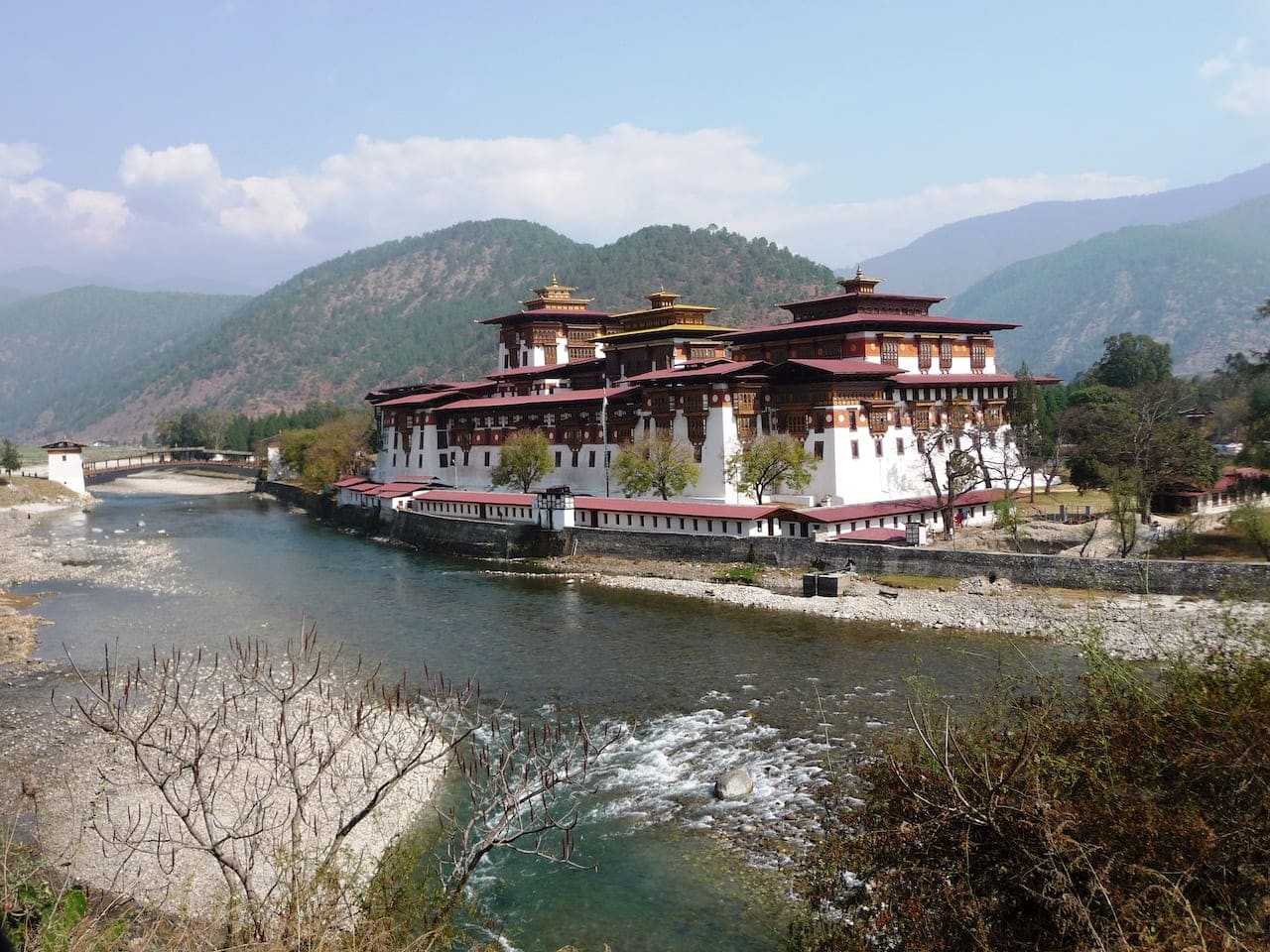
See an image gallery of sights, people, Dzongs, festivals and more of the wonders of beautiful Bhutan
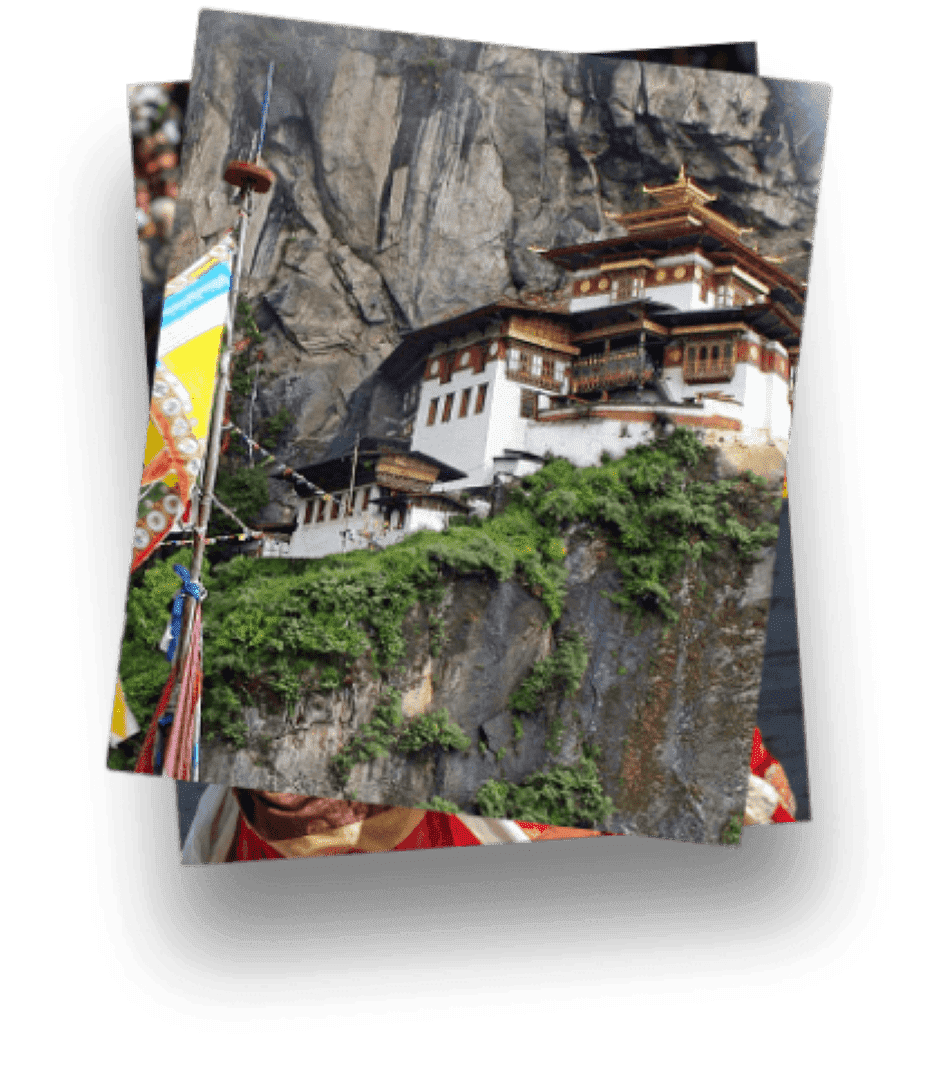
Read our Bhutan Travel Guide

All rights reserved. Snow Cat Travel is a Registered Trade Mark UK 00003289264

